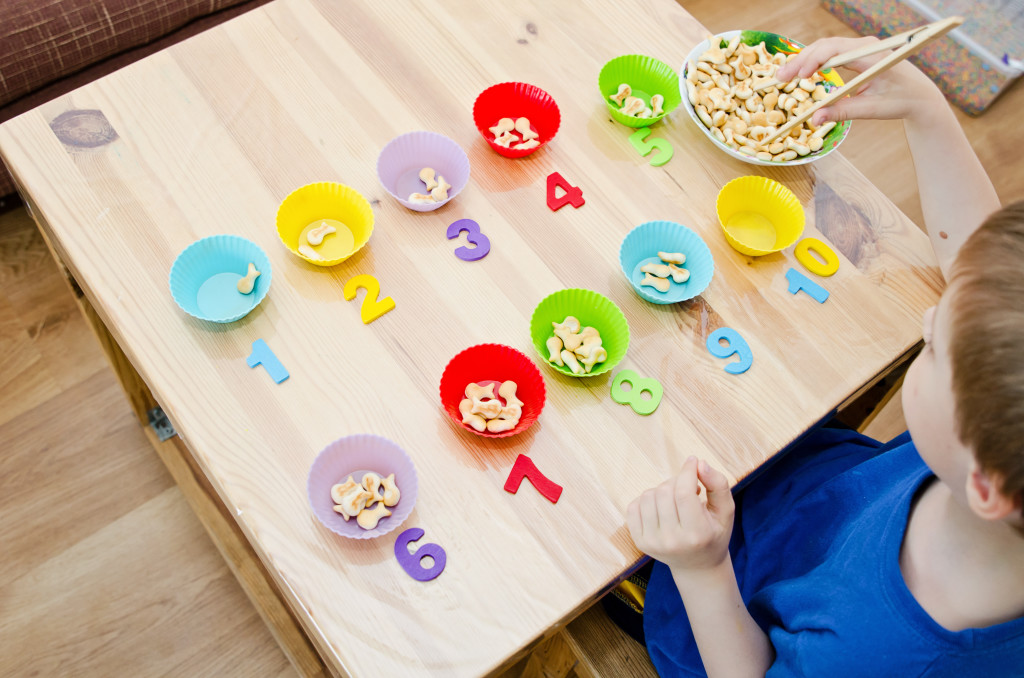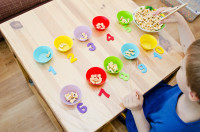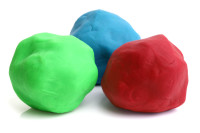
Dear Melissa:
My son is in kindergarten and is having difficulty with holding a pencil, cutting, and other fine motor tasks. Is there anything we can do at home to help improve his fine motor skills?
Before I delve into this question, let me give you my philosophy on “Home Exercise Programs” and the roles of therapists vs. parents.
As a therapist, it is my job to teach a child new skills and to work at those skills. In teaching, it is also my job to make sure they don’t realize they are “working” and just think they get to play with a really crazy-fun adult 1-2 times per week. As the mom, dad, grandparent, aunt, babysitter, etc., it is your job to have fun with your kiddo by making sure that these “Home Exercise Programs” are simply awesome-fun games that just happen to promote fine motor skills.
Now on the to the fun!
Children need to develop gross motor skills first.
All humans develop gross motor skills first, then move on to fine motor skills. Think about it. Babies learn to roll and sit up first, before they can pick up a tiny Cheerio on their highchair tray with their fingers.
Here are my favorite fine-motor-promoting gross motor activities, that support both trunk strengthening (which is a precursor for fine motor skills) and upper extremity, as well as promote overall gross motor coordination skills. Both strengthening AND coordination are the foundation for fine motor skills.
Animal Walks: Crawling is SO important! It strengthens the whole shoulder/arm areas, as well as promotes coordination skills AND puts weight through the hands which strengthens the tiny intrinsic muscles. These tiny muscles are so crucial for handwriting, cutting, and other fine motor skills. Some examples of animal walks include:
- Crawling like a cat/dog
- Crab walking
- Bear walking
- Alligator crawling (army crawling)
Dance parties: Either find a YouTube dance video to imitate, or just turn up the music and have fun! This works on strength, coordination, and endurance. Super fun!
Balloon batting: I do this one all the time in the clinic. Balloons are fun. They make me happy. Work on eye-hand coordination and control by hitting a balloon back and forth, or get several family members together to play a balloon-volleyball game!
Clapping hand games: Remember “Cinderella dressed in yella” and “Miss Mary Mack”? I remember playing these games on the elementary school playground. Now, I simplify these hand games so that I can play them with my kids/niece/nephew while waiting for a table at a restaurant or anywhere we are waiting for a few minutes. They love them! Start with just alternating between a “high 10” and clapping, and move on up to crossing midline for “high 5’s” and those hand game patterns you remember from your own childhood.
Obstacle courses: Yes, it’s fantastic if you happen to have tunnels and balance beams at your disposal, but you can make fantastic obstacle courses with items that are already in your home. Crawl under kitchen chairs, jump over wooden spoons, lay out a scarf as a “balance beam,” use magazines as stepping stones, use your imagination!
Now to the fine motor skills fun…
 Tongs: Either find therapy tongs on amazon.com or simply go to a kitchen store and locate “appetizer tongs.” You can use the tongs to sort out tiny items, or even more fun, use these tongs like chopsticks to eat your favorite snack. They can even be used to eat chicken nuggets and French fries!
Tongs: Either find therapy tongs on amazon.com or simply go to a kitchen store and locate “appetizer tongs.” You can use the tongs to sort out tiny items, or even more fun, use these tongs like chopsticks to eat your favorite snack. They can even be used to eat chicken nuggets and French fries!
Sidewalk chalk: What fantastic sunny-day fun! Get out a bucket of side walk chalk and work together to draw a beautiful scene. Sidewalk chalk is fantastic for strengthening the hand muscles needed for handwriting, and it is so much fun!
Water guns/squirters: When this sunny day gets a bit too toasty, pull out the water toys! Water toys with a trigger, such as a water gun, really work to strengthen the index finger. Ball-shaped water squirters work to strengthen the whole hand, and those tube-shaped water cannons work to promote coordination between the right & left sides of the body.
Coloring: Coloring is my favorite Saturday morning activity with my daughter. But, I realize that kiddos with fine motor difficulties often don’t enjoy coloring. Explore various colored pencils/markers/crayons, as well as various character books or Color Wonder papers. If your child happens to like coloring, break the crayons in half to promote further finger strengthening as well as develop a more mature grasping pattern.
 Play dough: Play dough, clay, theraputty, cookie dough… They are all fantastic landscapes to work on finger strengthening by pinching/pulling, and bilateral arm coordination by using both hands to roll out dough into “snakes” or by using a rolling pin.
Play dough: Play dough, clay, theraputty, cookie dough… They are all fantastic landscapes to work on finger strengthening by pinching/pulling, and bilateral arm coordination by using both hands to roll out dough into “snakes” or by using a rolling pin.
Clothespins: This one seems a bit boring to me personally, but I am always amazed by how often my patients pick the clothespin activities. In the clinic, we draw various animal bodies onto note cards, and then the children use the clothespins to add arms, tentacles, tails, etc.
Dress-up: Does your kiddo hate sitting at the table? Dress-up may be your activity! Buttoning, lacing, zipping, tying… There are SO many fine motor skills required for dressing. It’s even better if your child likes to switch characters frequently!
Beads/lacing: This can go hand-in-hand with dress-up, or as a stand-alone activity. If your child has difficulty with stringing beads, aim for larger beads, and you can even string them on pipe cleaners instead of string to make necklaces, bracelets, belts, headbands… The possibilities are endless.
Tape: This is my daughter’s idea, and one where I have had to just take a deep breath and let it gooooo. She loves to tape things when she makes various art projects. The bilateral coordination and finger strength required for taping are really fantastic. Tearing off pieces of tape is actually an item on one of our OT standardized tests. So… I just buy her a roll of scotch tape every month or so, and then turn my back as she “wastes” the whole roll creating some fantastic project (while making her fingers stronger at the same time)!
 Art projects: Honestly, I can’t think of a single art project that wouldn’t help a child develop fine motor skills. Painting, sculpting, coloring, cutting, lacing… The possibilities really are endless. Go to the cheap craft or dollar section, and then let your child decide. It is amazing how adding a little bit of choice/control can greatly improve a child’s participation in an activity.
Art projects: Honestly, I can’t think of a single art project that wouldn’t help a child develop fine motor skills. Painting, sculpting, coloring, cutting, lacing… The possibilities really are endless. Go to the cheap craft or dollar section, and then let your child decide. It is amazing how adding a little bit of choice/control can greatly improve a child’s participation in an activity.
Resources:
Indoor Gross Motor Activities, Children’s Therapy TEAM Blog, with OT Melissa Foster
Water Day, Children’s Therapy TEAM Blog, with OT Melissa Foster
About the author
Melissa Foster is a Nationally Board Certified Occupational  Therapist who received her Masters in Occupational Therapy from University of Central Arkansas in 2004. She came to TEAM in 2013 with a wealth of treatment experience in settings that range from NWA to Kansas to New York. Her primary interests are treatment of children on the Autism Spectrum, treatment of children with ADHD and treatment of children with sensory processing and behavioral disorders. Melissa is an active public speaker in the NWA community on topics related to Autism and Sensory Processing Disorder. She has authored several resource materials for parents on topics such as sleep and picky eating. Her blog for parents addresses a new topic every Monday and has become a popular resource for families. Melissa loves spending time with her husband and their two children. On warm summer days she enjoys sitting on her patio with a good book and a glass of iced tea.
Therapist who received her Masters in Occupational Therapy from University of Central Arkansas in 2004. She came to TEAM in 2013 with a wealth of treatment experience in settings that range from NWA to Kansas to New York. Her primary interests are treatment of children on the Autism Spectrum, treatment of children with ADHD and treatment of children with sensory processing and behavioral disorders. Melissa is an active public speaker in the NWA community on topics related to Autism and Sensory Processing Disorder. She has authored several resource materials for parents on topics such as sleep and picky eating. Her blog for parents addresses a new topic every Monday and has become a popular resource for families. Melissa loves spending time with her husband and their two children. On warm summer days she enjoys sitting on her patio with a good book and a glass of iced tea.
